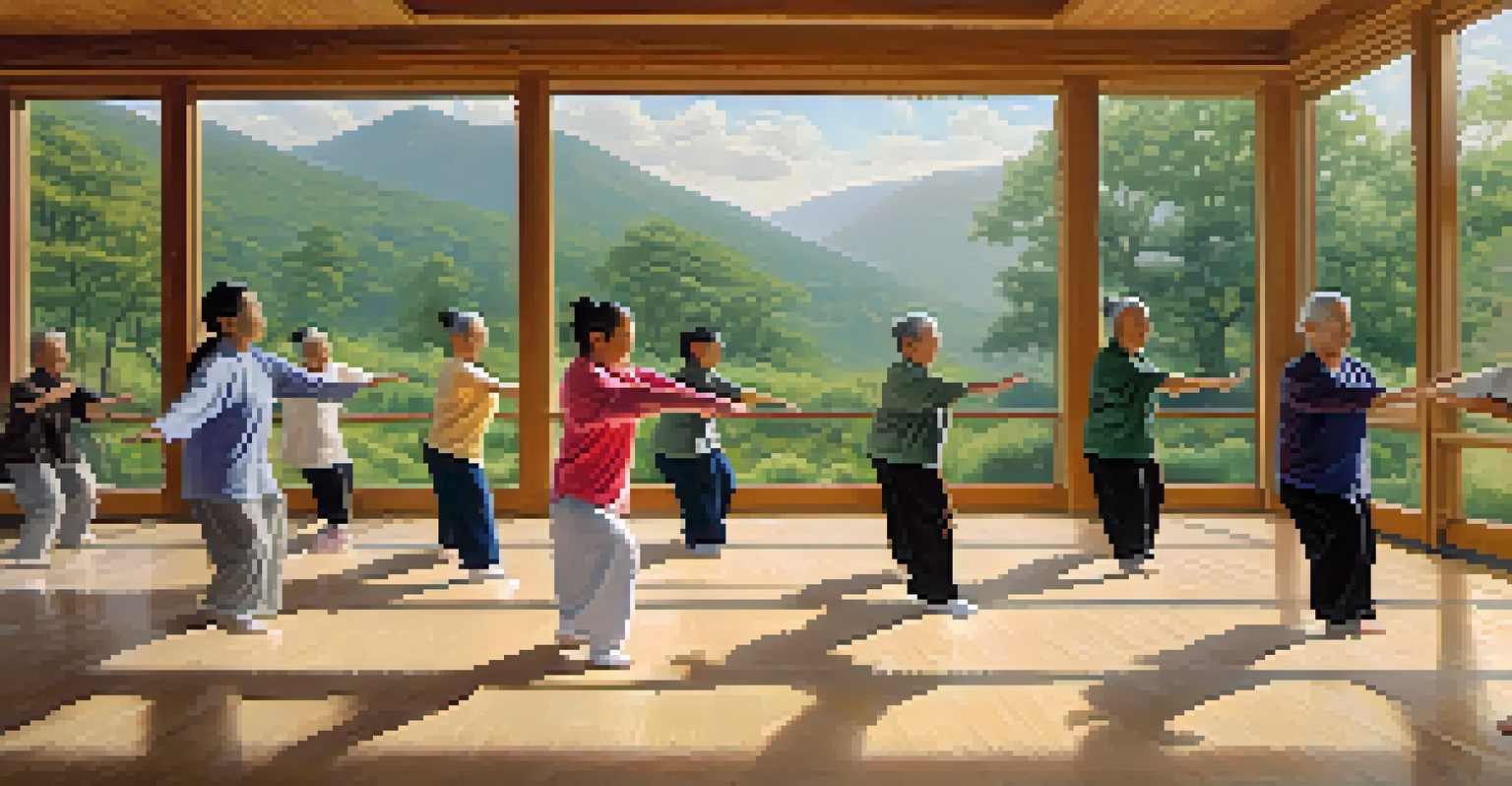Exploring Tai Chi: A Gentle Exercise for Stress Relief

What is Tai Chi and Its Origins
Tai Chi, often described as 'meditation in motion', is a gentle form of martial art that originated in China. It combines slow, deliberate movements with deep breathing and mental focus, creating a harmonious flow of energy. This practice has deep roots in Chinese philosophy, particularly Taoism, which emphasizes living in balance with the universe.
Tai Chi is a practice that enables you to find balance and harmony in your life.
Historically, Tai Chi was developed as a self-defense technique, but over the centuries, it has evolved into a form of exercise that promotes relaxation and well-being. It is now practiced worldwide, appreciated for its health benefits rather than its martial applications. The beauty of Tai Chi lies in its ability to be accessible to people of all ages and fitness levels.
Whether you are looking to improve your physical health or seeking a way to calm your mind, Tai Chi offers a unique blend of movement and mindfulness that can enhance your overall quality of life.
The Health Benefits of Practicing Tai Chi
Tai Chi is often lauded for its numerous health benefits, particularly in reducing stress and anxiety. Studies have shown that engaging in this gentle exercise can lower cortisol levels, the hormone associated with stress. By incorporating deep, rhythmic breathing, practitioners can achieve a state of relaxation that can significantly improve mental clarity and emotional resilience.

Moreover, Tai Chi enhances physical health by improving balance, flexibility, and overall strength. The slow, flowing movements help to build muscle tone without the strain often associated with more vigorous forms of exercise. This makes Tai Chi an excellent option for older adults or those recovering from injury, as it allows them to engage in physical activity safely.
Tai Chi: A Holistic Practice
Tai Chi is a gentle martial art that combines movement, mindfulness, and breathing to promote overall health and well-being.
Regular practice of Tai Chi can also lead to better sleep quality, which is essential for managing stress. When the body is relaxed and the mind is calm, it becomes easier to fall asleep and stay asleep, creating a virtuous cycle of health and well-being.
How to Get Started with Tai Chi
Starting your Tai Chi journey can be as simple as finding a local class or an online tutorial. Many community centers, gyms, and wellness studios offer beginner classes that focus on the fundamentals. It's advisable to choose a class that suits your schedule and comfort level, ensuring you feel at ease as you learn.
The mind is like water. When it’s turbulent, it’s difficult to see. When it’s calm, everything becomes clear.
If you prefer practicing at home, there are many resources available, including instructional videos and apps that guide you through basic movements. Starting with just a few minutes of practice each day can make a significant difference over time. Remember, consistency is key, and it's better to practice regularly, even if for a short duration, than to overexert yourself initially.
As you begin, focus on the quality of your movements rather than the quantity. Tai Chi is about flowing and feeling, not rushing through a series of poses. With patience and practice, you’ll soon find yourself moving with grace and enjoying the meditative aspects of this beautiful art.
Different Styles of Tai Chi: Which One is Right for You?
There are several styles of Tai Chi, each with its own unique characteristics and philosophies. The most popular styles include Yang, Chen, Wu, and Sun, each offering different approaches to movement and practice. Yang style, for instance, is known for its gentle, flowing movements, making it particularly accessible for beginners.
Chen style, on the other hand, incorporates more explosive movements and is often considered more physically demanding. Wu style focuses on a higher stance and is known for its subtle and graceful movements. As you explore Tai Chi, you may find that trying out different styles will help you identify what resonates most with your personal preferences and goals.
Accessibility for All Ages
Despite common misconceptions, Tai Chi is suitable for people of all ages and fitness levels, making it an inclusive form of exercise.
Ultimately, the best style of Tai Chi for you is the one that you enjoy and feel comfortable practicing. This enjoyment will motivate you to practice regularly, reaping the mental and physical benefits of this ancient art.
Incorporating Tai Chi into Your Daily Routine
Incorporating Tai Chi into your daily life can be as simple as setting aside a few minutes each day for practice. Many practitioners find that morning is the best time to engage in Tai Chi, as it prepares both the body and mind for the day ahead. However, any time that allows you to focus and connect with your breath can be beneficial.
You can also integrate Tai Chi principles into other aspects of your life. For example, while standing in line or waiting for an appointment, you might practice your stance or focus on your breathing. This not only helps you stay grounded during stressful moments but also reinforces the mindfulness aspect of Tai Chi.
As you become more comfortable with the movements and philosophy of Tai Chi, consider sharing it with friends or family. Practicing together can enhance your experience and create a supportive community that encourages everyone to embrace this wonderful form of exercise.
Common Misconceptions About Tai Chi
Despite its growing popularity, there are still some misconceptions about Tai Chi that may prevent people from trying it. One common belief is that Tai Chi is only for elderly individuals or those with limited mobility. While it is true that many seniors benefit from its gentle nature, people of all ages can practice Tai Chi to improve their health and well-being.
Another misconception is that Tai Chi is merely a slow form of exercise without any real benefits. In reality, Tai Chi is a comprehensive practice that engages both the body and mind. It cultivates strength, flexibility, and balance while promoting mental clarity and emotional calmness.
Real Benefits Beyond Movement
Practicing Tai Chi can lead to improved mental clarity, reduced stress, and enhanced physical strength, offering significant benefits for practitioners.
By addressing these misconceptions, we can encourage more individuals to explore the benefits of Tai Chi. It’s important to approach it with an open mind and a willingness to experience its unique, holistic approach to health.
Real-Life Success Stories of Tai Chi Practitioners
Many individuals have experienced remarkable transformations through the practice of Tai Chi. For example, a busy professional shared how incorporating Tai Chi into her morning routine helped her manage stress and improve focus throughout her workday. She found that just a few minutes of practice each morning set a positive tone for the day ahead.
Another inspiring story came from an older gentleman who began practicing Tai Chi after a fall left him with limited mobility. Over time, he regained strength and confidence, allowing him to engage more fully in life. He often shares how the gentle movements of Tai Chi not only improved his physical health but also lifted his spirit.

These stories highlight the profound impact Tai Chi can have on individuals from all walks of life. Whether it’s improving mental clarity, enhancing physical strength, or fostering a sense of community, Tai Chi offers something valuable for everyone.